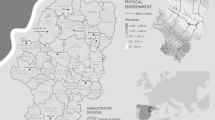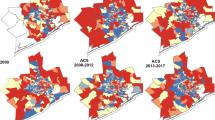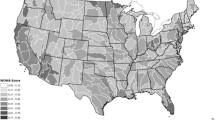Abstract
This paper examines methods for quantitatively identifying communities that have high social vulnerability to environmental hazards. We first provide an overview of the existing literature on quantifying social vulnerability. We discuss the strengths and weaknesses of the one of the most common methods, composite indexing using principal component analysis (PCA), in more detail. We present a case study of Hampton Roads, Virginia, that compares PCA-based composite indexing to an alternative method using k-means clustering to identify socially vulnerable communities. We find that PCA-based indexing is particularly sensitive to changes in geographic boundaries and the number of input variables while clustering is less so. However, both methods exhibit the highest levels of consistency when vulnerability is measured by a relatively small number of well-established quantitative indicators. While the cluster method is more intuitive and easier to interpret than composite indexing, it is not well suited for large analyses across a disparate geographic area or where one needs to explicitly rank observations.

Similar content being viewed by others
Notes
42 U.S.C. 5151.
Abdi and Williams (2010) provide a more complete description of the PCA method.
While this list is not exhaustive, it does provide a large cross section of the literature.
This is certainly not the first paper to point this out. For example, Tate (2012) and Tate (2013) also discuss how these factors, as well as a number of other factors, affect the construction of a composite index. However, our approach to comparing PCA-based composite indexing to a cluster analysis approach focusing on these factors is, to the best of our knowledge, unique.
For example Sherrieb, Norris and Galea (2010) conduct a correlation analysis of existing social vulnerability composite indices using county-level data from the state of Mississippi find a relatively low correlation of these indices with survey measures of social cohesion (correlation −0.17) and collective efficacy (correlation −0.10).
Tate (2013) and Wolters and Kuenzer (2015) discuss a third option, the use of parametric indicators or component weights assigned based on parameters assessed from outside information such as expert opinion or econometric analysis. While expert-derived or parametrically-weighted indices might offer greater validity than other approaches to weighting, they have disadvantage of requiring additional analysis or researcher judgment. Thus we chose to focus on the two weighting options that do not rely on additional information or inputs.
Tate (2012) shows that the granularity of the analysis does have a significant effect on PCA-based indices.
Cutter et al. (2013) also investigate the consistency of various PCA-based indices under changes in geographic boundaries. However, they examine applying the same index construction method to distinctly different geographic areas while we consider applying the same method to different overlapping geographic boundaries.
Since the cluster analysis approach does not use weights, we do not compare the methods on this dimension.
Some of the key variables used in the analysis are available only from the American Community Survey (ACS). Because the ACS samples approximately 1 in 40 households every year, the error bounds for smaller geographies such as block groups are subject to significant sampling error.
The Cutter et al. (2003) study used 42 variables; however, we were unable to find recent data on general local government debt to revenue ratios—thus we only include 41 of the original variables in our analysis.
We use 2010 as the base year for this study. Variables that were collected from a source other than the 2010 Census were collected as close to 2010 as possible.
All variables were standardized relative to the means for all the 1874 census tracts in Virginia. As a sensitivity analysis, we examined whether it made a difference if the variables were standardized with respect to all Virginia census tracts or to the particular geography used for that index (e.g., coastal Virginia or Hampton Roads) and found little difference in the results.
Cutter et al. (2013) also report the Cronbach alpha test for pairwise comparisons of indices. For our indices the Pearson’s R correlation and the Cronbach alpha test provide the same results.
Some papers categorize observations into bins representing different levels of vulnerability. For those studies, we consider how the most vulnerable group is categorized.
This excludes 7 census tracts in city of Franklin and county of Southampton that are considered part of Hampton Roads, but are not in a coastal county.
Another alternative we initially considered was the data envelopment analysis (DEA) method that Clark et al. (1998) use to combine common factors into a single scalar, but which also allows for observations that have high values on only one component to score highly on the vulnerability index. One could characterize the DEA method as a hybrid of the PCA and cluster method as DEA uses components produced by an initial factor analysis as inputs, rather than individual variables. Thus some of the concerns about PCA-based approaches also apply to the DEA method.
See Mirkin (2013) for a thorough discussion of cluster analysis.
We used the η 2 measure to assess the improvement in fit that resulted from additional runs (Makles, 2012). We conducted a series of cluster analyses using the VA41 dataset, calculating η 2 after each 100 runs up to 1000 and then repeated the series 5 times. After 100 runs, η 2 ranged from 64.1 to 64.6 %. After 500 runs, η 2 ranged from 64.2 to 64.9 % with a maximum increase of 0.8 % points. After 1000 runs, η 2 ranged from 64.6 to 64.9 % and the maximum increase was 0.5 % points. We therefore decided that 500 runs were sufficient given the small probability that doubling the number of runs would result in a significant improvement in fit.
The results using the η 2 > 2 % points decision rule are very similar to the result we get if we chose 30 clusters for all 9 geography/input set combinations.
Importantly, many clusters meet more than one of the decision rules below.
Thus a tract considered marginally vulnerable in one analysis and highly vulnerable in the other is considered to be correctly characterized while a tract considered marginally vulnerable in one analysis and not vulnerable in the other is considered to be mischaracterized.
Similar to other studies, we do find that it may not be necessary to include race in a PCA-based index because the most important racial variable of interest, percent black, is strongly correlated with other included variables such as income (correlation −0.69), percent in poverty (0.67), percent with no high school degree (0.70), and percent female head of household (0.84). While this is useful for policymakers who may wish to or need to avoid explicitly specifying race as a criterion of analysis for legal or political reasons, to the extent that race may increase vulnerability on its own, we believe it should be included in measures of social vulnerability.
References
Abdi H, Williams LJ (2010) Principal component analysis. Wiley Interdiscip Rev Comput Stat 2:433–459
Armaş I, Gavriş A (2013) Social vulnerability assessment using spatial multi-criteria analysis (SEVI model) and the Social Vulnerability Index (SoVI model)—a case study for Bucharest, Romania. Nat Hazards Earth Syst Sci 13:1481–1499
Baum S, Horton S, Choy DL (2008) Local urban communities and extreme weather events: mapping social vulnerability to flood. Australas J Reg Stud 14:251–273
Bjarnadottir S, Li Y, Stewart MG (2011) Social vulnerability index for coastal communities at risk to hurricane hazard and a changing climate. Nat Hazards 59:1055–1075
Blaikie PM, Cannon T, Davis I, Wisner B (1994) At risk: natural hazards, people’s vulnerability and disasters. Routledge, London
Boruff BJ, Emrich C, Cutter SL (2005) Erosion hazard vulnerability of US coastal counties. J Coast Res 21:932–942
Burton CG (2010) Social vulnerability and hurricane impact modeling. Nat Hazards Rev 11:58–68
Burton C, Cutter SL (2008) Levee failures and social vulnerability in the Sacramento-San Joaquin delta area, California. Nat Hazards Rev 9:136–149
California Emergency Management Agency (2013) State hazard mitigation plan. http://hazardmitigation.calema.ca.gov/plan/state_multi-hazard_mitigation_plan_shmp
Chakraborty J, Tobin GA, Montz BE (2005) Population evacuation: assessing spatial vulnerability in geophysical risk and social vulnerability to natural hazards. Nat Hazards Rev 6:23–33
Chang SE, Yip JZK, de Jong SLVZ, Chaster R, Lowcock A (2015) Using vulnerability indicators to develop resilience networks: a similarity approach. Nat Hazards 78:1827–1841
Clark G, Moser S, Ratick K, Dow W, Meyer S, Emani W, Jin J, Kasperson R, Schwartz H (1998) Assessing the vulnerability of coastal communities to extreme storms: the case of Revere, MA, USA. Mitig Adapt Strat Glob Change 3:59–82
Climate Central (2016) Suring seas: sea level rise analysis by climate central. http://sealevel.climatecentral.org/. Accessed 2016
Cutter SL (1996) Vulnerability to environmental hazards. Prog Hum Geogr 20:529–539
Cutter SL, Finch C (2008) Temporal and spatial changes in social vulnerability to natural hazards. Proc Natl Acad Sci 105:2301–2306
Cutter SL, Boruff BJ, Shirley WL (2003) Social vulnerability to environmental hazards. Soc Sci Q 84:242–261
Cutter SL, Emrich CT, Morath DP, Dunning CM (2013) Integrating social vulnerability into federal flood risk management planning. J Flood Risk Manag 6:332–344
de Oliveira Mendes JM (2009) Social vulnerability indexes as planning tools: beyond the preparedness paradigm. J Risk Res 12:43–58
Fekete A (2012) Spatial disaster vulnerability and risk assessments: challenges in their quality and acceptance. Nat Hazards 61:1161–1178
Finch C, Emrich C, Cutter SL (2010) Disaster disparities and differential recovery in New Orleans. Popul Environ 3:179–202
Fothergill A, Peek LA (2004) Poverty and disasters in the United States: a review of recent sociological findings. Nat Hazards 32:89–110
Fothergill A, Maestas E, Darlington JD (1999) Race, ethnicity and disasters in the United States: a review of the literature. Disasters 23:156–173
Holand IS, Lujala P (2013) Replicating and adapting an index of social vulnerability to a new context: a comparison study for Norway. Prof Geogr 65:312–328
Makles A (2012) How to get the optimal k-means cluster solution. Stata J 12:347–351
Martinich J, Neumann J, Ludwig L, Jantarasami L (2013) Risks of sea level rise to disadvantaged communities in the United States. Mitig Adapt Strat Glob Change 18:169–185
McNeeley SM (2014) A “toad’s eye” view of drought: regional socio-natural vulnerability and responses in 2002 in Northwest Colorado. Reg Environ Change 14:1451–1461
Mirkin Boris (2013) Clustering: a data recovery approach, 2nd edn. CRC Press, Boca Raton
Myers CA, Slack T, Singelmann J (2008) Social vulnerability and migration in the wake of disaster: the case of Hurricanes Katrina and Rita. Popul Environ 29:271–291
National Oceanic and Atmospheric Administration (2016) Sea level rise and coastal flooding impacts. http://coast.noaa.gov/slr/. Accessed 2016
O’Keefe P, Westgate K, Wisner B (1976) Taking the naturalness out of natural disasters. Nature 260:566–567
Pacific Institute (2016) Mapping social vulnerability to climate change in California. http://www2.pacinst.org/reports/climate_vulnerability_ca/maps/about.html. Accessed 2016
Rygel L, O’Sullivan D, Yarnal B (2006) A method for constructing a social vulnerability index: an application to hurricane storm surges in a developed country. Mitig Adapt Strat Glob Change 11:741–764
Schmidtlein MC, Shafer JM, Berry M, Cutter SL (2011) Modeled earthquake losses and social vulnerability in Charleston, South Carolina. Appl Geogr 31:269–281
Sherrieb K, Norris FH, Galea S (2010) Measuring capacities for community resilience. Soc Indic Res 99:227–247
Solangaarachchi D, Griffin AL, Doherty MD (2012) Social vulnerability in the context of bushfire risk at the urban-bush interface in Sydney: a case study of the Blue Mountains and Ku-ring-gai local council areas. Nat Hazards 64:1873–1898
Tate E (2012) Social vulnerability indices: a comparative assessment using uncertainty and sensitivity analysis. Nat Hazards 63:325–347
Tate E (2013) Uncertainty analysis for a social vulnerability index. Ann As Am Geogr 103:526–543
Tate E, Cutter SL, Berry M (2010) Integrated multihazard mapping. Environ Plan B Plann Des 37:646–663
Toké NA, Boone CG, Arrowsmith JR (2014) Fault zone regulation, seismic hazard, and social vulnerability in Los Angeles, California: hazard or urban amenity? Earth’s Future 2:440–457
Turner BL, Kasperson RE, Matson PA, McCarthy JJ, Corell RW, Christensen L, Eckley N, Kasperson JX, Luers A, Martello ML, Polsky C, Pulsipher A, Schiller A (2003) A framework for vulnerability analysis in sustainability science. Proc Natl Acad Sci 100:8074–8079
Virginia Institute of Marine Sciences (2013) Report to the Governor, Senate Document No. 3: Recurrent Flooding Study for Tidewater Virginia
Wang C, Yarnal B (2012) The vulnerability of the elderly to hurricane hazards in Sarasota, Florida. Nat Hazards 63:349–373
Wolters ML, Kuenzer C (2015) Vulnerability assessments of coastal river deltas—categorization and review. J Coast Conserv 19:345–368
Wood NJ, Burton CG, Cutter SL (2010) Community variations in social vulnerability to Cascadia-related tsunamis in the U.S. Pacific Northwest. Nat Hazards 52:369–389
Acknowledgments
Funding was provided by Blue Moon Fund (Grant no. 775602A-712685).
Author information
Authors and Affiliations
Corresponding author
Rights and permissions
About this article
Cite this article
Stafford, S., Abramowitz, J. An analysis of methods for identifying social vulnerability to climate change and sea level rise: a case study of Hampton Roads, Virginia. Nat Hazards 85, 1089–1117 (2017). https://doi.org/10.1007/s11069-016-2622-4
Received:
Accepted:
Published:
Issue Date:
DOI: https://doi.org/10.1007/s11069-016-2622-4




